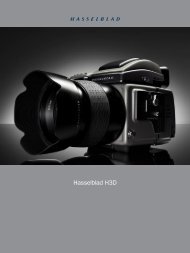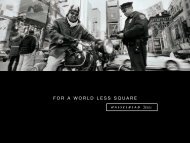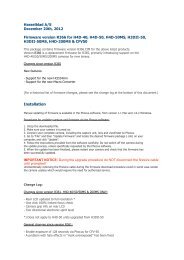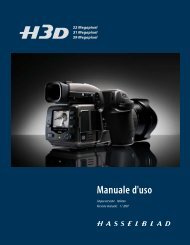VerSATile AS A SWiSS Army knife - Hasselblad
VerSATile AS A SWiSS Army knife - Hasselblad
VerSATile AS A SWiSS Army knife - Hasselblad
- No tags were found...
You also want an ePaper? Increase the reach of your titles
YUMPU automatically turns print PDFs into web optimized ePapers that Google loves.
HC 4/120: The HC 4/120 is a classicmacro lens that reaches a 1:1 reproductionscale without addingextension tubes. Its optical excellenceand its versatility gives itan almost legendary standingamongst H photographers. It is aclassic portrait focal length thatcan be used for far more than justclose-up photographyHC 3,2/150: Thanks to highspeed and moderate telephotoeffect the HC 3,2/150 is a finechoice in classic portraiture –and a prime choice in landscapephotographyHC 4/210: The counterpart tothe classic 135 mm lens in 35 mmphotography comes in the formof the HC 4/210 – a classic telephotolens with outstanding performancestatistics. The 210 mm iseffective in both portraiture andlandscape photography, generatingthat slightly compacted, typicaltelephoto perspectiveHC 4,5/300: The ‘longest’ telephotolens in the H series is ideal forwildlife and sports photography,where it draws even the shiest ofmammals and energetic of actionsup close. Mounted in conjunctionwith the H1.7X converter the lensmutates into a beastly 500 mm ofexceptional qualityHC 3,5-4,5/50-110: Zoom lensesare easy to use and practical,enabling you to quickly respond tochanging conditions. The HC 3,5-4,5/50-110 covers an invaluablephotographic spectrum rangingfrom slight wide angle to portraittelephoto. As a zoom it has noproblem keeping up with the speedand reproduction values of fixedfocal lengths. Its versatility is whatmakes it one of the most popularHC lenses of allH System vs. 35 mm lensescorrectable. Chromatic aberration,in turn, is prevented almost entirely.To design a ‘digital’ lens with similarperformance statistics – but withoutDAC – would require tremendouseffort. Thanks to DAC, however, theHE extension rings: Availablewith 13, 26 and 52 millimeters,the HE extension ringsallow macro photography withall HC/HCD lensesConverter H1.7X: The convertercan freely be combined with allHC/HCD lenses except the wideangles and zooms, vastly increasingtheir range of useObjektiv Diag. angle of view Diag. angle of view Diag. angle of viewH3DII-39 and -50 H3DII-31 H2F w. 645-film(35 mm focal length) (35 mm focal length) (35 mm focal length)HCD 4/28 93° (20 mm) 87° (23 mm) –HC 3.5/35 81° (25 mm) 75° (28 mm) 87° (23 mm)new super wide-angle remains smallHC 3.5/50 63° (35 mm) 58° (39 mm) 68° (32 mm)and compact and, not least, moreaffordable. Similarly for the HTS 1.5tilt and shift adapter that withoutDAC wouldn’t permit all combi-in practice. The table on the right displaysthe HC/HCD lenses alongsidewith their 35 mm counterparts.In addition to the HC/HCD lensesextends the range of HC/HCD lensesat the telephoto end with the exceptionof the wide-angle and zoomlenses. For close-ups there are the HEHC 2.8/80 41° (58 mm) 37° (64 mm) 45° (52 mm)HC 2.2/100 34° (71 mm) 31° (78 mm) 38° (64 mm)HC 4/120 29° (84 mm) 26° (93 mm) 32° (75 mm)nations to be adjusted for withouterrors. In other words, DAC is essentialto the production of innovativeproducts such as the HTS 1.5 or theon these pages, <strong>Hasselblad</strong>’s lensgamut holds several other specialtiesin stock, such as the CF adapterfor compatibility with the legend-extension rings with 13, 26 and 52mm lengths. Depending on the lens,the extension tubes and converterscan be combined with each other,HC 3.2/150 23° (106 mm) 21° (118 mm) 26° (95 mm)HC 4/210 17° (149 mm) 15° (165 mm) 18° (134 mm)HC 4.5/300 12° (206 mm) 11° (229 mm) 13° (186 mm)HCD 4/28. The best thing about DACary Zeiss lenses of the V system. Theand, apart from a few exceptions,HCD 4-5.6/35-90 81–39° (26–61 mm) 75–35° (26–68 mm) –is its transparency: the photographerhas only to press the exposure buttonH camera’s autofocus mechanismallows for sublime focus control andthe AF function remains operational.Since the converters and extensionHC 3.5-4.5/50-110 62–32° (36–76 mm) 56–29° (40–85 mm) 67–35° (33–69 mm)and convert the photo in Phocus tothe camera’s exposure meter displaystubes are fully integrated in DAC theyremove all aberrations automatically.the speed and aperture to be trans-can be used without restriction. Theto resurrect their old view cameras orto macro and from universal zoom toIn theory, with the right amount offerred to the lens. In the case of CFEHC/HCD’s outstanding performanceperhaps even setting for lower-qual-a specialized tilt and shift solution.craftsmanship and willingness tolenses, the aperture setting is trans-statistics will be preserved from closeity solutions from the 35 mm market.There’s bound to be the right lens forexperiment you could limit errorsferred to the camera. The CF lensrange to extended telephoto.The temptation of being able to useeveryone. And the strength of thelike vignetting, and even distortion,adapter greatly expands the range ofthe outstanding HC/HCD lensessystem isn’t only in its vast portfoliousing Photoshop. But Phocus withDAC delivers the optimal solutioncompatible lenses for H3DII users;take the 500 mm CF lens, for exam-CONCLUSIonwith tilt and shift functionality,fused with cameras with impres-and complete coverage of needs; it’sthe reliability with which HC/HCDautomatically.ple, which currently lacks an equal inThe palette of HC/HCD lenses couldsively large image sensors, is beyondlenses are known to deliver highthe H system. CF lens users may nothave be considered complete sinceseductive. The new zoom, in turn,performance across the board. AndSpecialitiescall upon DAC yet, but it doesn’t stopthese renowned lenses from livingthe introduction of the HCD 4/28.Now, however, the HTS 1.5 tilt andis as universal as a Swiss army <strong>knife</strong>and may cover all your photographicthis is what counts: tools that alwayswork, never abandon you and alwaysThe H3DII-31’s slightly smaller sen-up to their outstanding reputationshift adapter and the new HCD 4-needs all by itself. <strong>Hasselblad</strong> cov-make the most of your possibilities.sor yields a 1.2 crop factor. That’s notwhen mounted on the H3DII.5.6/35-90 Aspherical expand theers with the HC/HCD lenses a veryenough to really change the characterThe offering is made completerange even further. The HTS 1.5 nowbroad range from super wide-angleFor further information please visitof a lens and rarely poses a problemwith the Converter H1.7X. It largelyspares <strong>Hasselblad</strong> users from havingto super telephoto, from ‘light giant’www.hasselblad.comSpecial/200839












